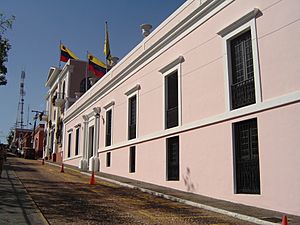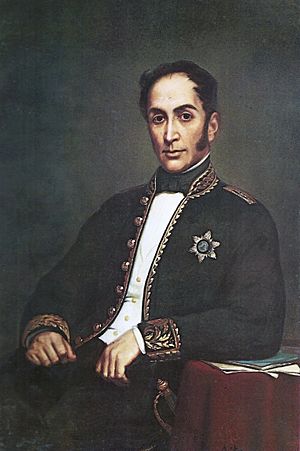Congress of Angostura facts for kids
The Congress of Angostura was a very important meeting. It was called by Simón Bolívar, a famous leader. The meeting happened in a city then called Angostura (now Ciudad Bolívar). This was during the wars when countries like Colombia and Venezuela were fighting to become free from Spain.
This congress led to the creation of a new, big country. It was called the Republic of Colombia. Historians often call it Gran Colombia to tell it apart from today's Republic of Colombia. The congress first met on February 15, 1819. It officially created the new nation on December 17, 1819. The meeting paused for a while because of the ongoing fight for independence. It then met again on July 31, 1821. This was when the Congress of Cúcuta started its work. Twenty-six delegates attended the Angostura assembly. They represented Venezuela and New Granada (which is now Colombia).
Contents
Why the Congress Was Needed
Many parts of these countries were still controlled by Spain. So, elections for the congress could only happen in areas that the freedom fighters controlled. These areas were in southern Venezuela and Margarita Island. Delegates from New Granada were chosen from people who had left their homes to fight with the Venezuelan patriots.
At the first meeting on February 19, 1819, Bolívar gave a famous speech. It was called the Address at Angostura. In his speech, Bolívar shared many ideas for the new government. However, not all of his ideas were accepted by the delegates. For example, he suggested a very powerful president for life and a senate where positions would be passed down in families. These ideas were similar to the government in the United Kingdom. He also suggested a "moral" branch of government. But these specific ideas were not chosen.
The Congress of Angostura is seen as Venezuela's second big meeting of lawmakers. The first one happened in 1811. The most important law passed by this congress was the Venezuelan Constitution of 1819. It was officially adopted on August 15, 1819. But it quickly became outdated. This happened when the Republic of Colombia was created on December 17, 1819.
This new nation, Gran Colombia, included Venezuela, New Granada (which is now Colombia and Panamá), and Quito (which is now Ecuador). To avoid confusion with the modern Republic of Colombia, historians use the name Gran Colombia. A new constitution for this big new nation was later created. This happened at the Congress of Cúcuta in August 1821.
The congress set up three large areas, called departments, for the new country:
- Venezuela (which is like the modern country of Venezuela).
- Cundinamarca (which is now Colombia, Panama, and some parts of Central America).
- Quito (which is now Ecuador).
Simón Bolívar was chosen as the president of Gran Colombia. Francisco Antonio Zea became the vice president. Juan Germán Roscio was the vice president for Venezuela. Francisco de Paula Santander was the vice president for Cundinamarca.
The Fundamental Law of Colombia
What the Law Said
On December 17, 1819, the congress members in Angostura (now Ciudad Bolívar) passed a very important law. It was called the Fundamental Law of the Republic of Colombia. This law had fourteen articles. It explained how the Republic of Gran Colombia would be set up.
The law said that the areas of Venezuela and New Granada should join together. They would form "a single republic." The law stated that these areas could not survive if they stayed separate. They were "united by the closest ties" and needed to be together. So, Gran Colombia was created out of "necessity and mutual interest."
Here are some of the main points from the Fundamental Law:
- Starting in 1819, the Republic of Colombia was created. It was formed by joining Venezuela and New Granada. Both of these areas had a republican system of government.
- The territories of Venezuela and New Granada would combine. This created a very large country.
- The new country, Colombia, would take on all the debts of both Venezuela and New Granada.
- The main power of the government would be held by a president and a vice-president. The congress would choose them for a temporary time.
- Venezuela, Quito, and Cundinamarca would be the three main departments of Gran Colombia. Cundinamarca replaced the old name of New Granada. Their main cities would be Caracas, Quito, and Bogotá.
- These departments would have their own leaders and administrations.
- The capital city of Colombia would be named after Bolívar. The congress would decide exactly where it would be located.
- The next congress for Colombia would meet in Rosario de Cúcuta in January 1821.
- This new congress would create the official Constitution for the Republic of Colombia.
- The congress would also decide on the "arms and flag of Colombia." The colors would be the same as Venezuela's flag because they were "most known."
- On January 15, 1820, the congress would take a break. New elections for the next congress could then happen.
- A small committee of six members and a president would take over after the congress adjourned.
- On December 25, 1819, the Republic of Colombia would be officially announced. This would be done with public celebrations. This date was chosen to remember the birth of Jesus.
- December 17 would be the anniversary of the Republic. This was because it was the day of its "political regeneration," meaning its new beginning.
Who Signed the Law
At the end of the Fundamental Law, you can find the signatures of the people who approved it. Francisco Antonio Zea was the president of the congress, and he signed it. Diego de Vallenilla, a delegate and secretary, also signed.
Other important politicians who signed the document included: Juan Germán Roscio, Manuel Cedeño, Juan Martínez, José España, Luis Tomás Peraza, Antonio M. Briceño, Eusebio Afanador, Francisco Conde, Diego Bautista Urbaneja, Juan Vicente Cardozo, Ignacio Muñoz, Onofre Basalo, Domingo Alzuru, José Tomás Machado, and Ramón García Cádiz.
Finally, Simón Bolívar himself approved the printing, sharing, and putting into action of the Fundamental Law. He did this with the official stamp of the State.
See also
 In Spanish: Congreso de Angostura para niños
In Spanish: Congreso de Angostura para niños



